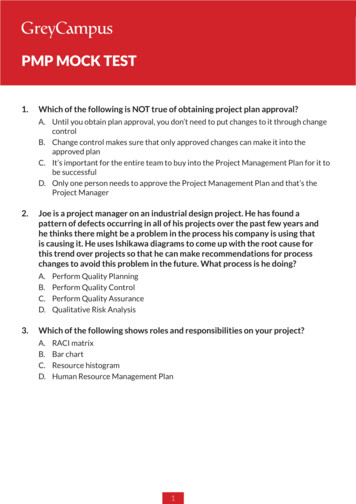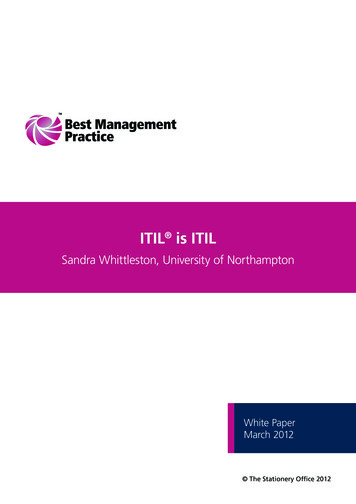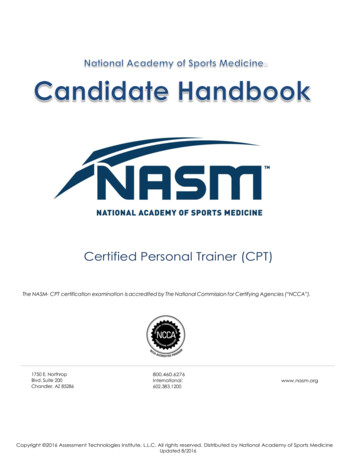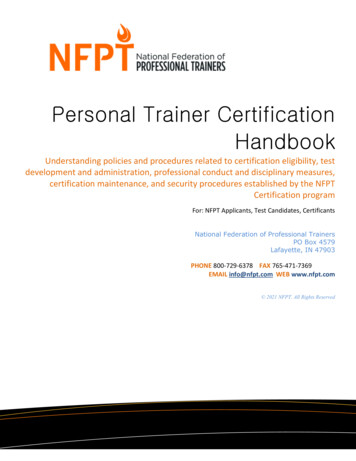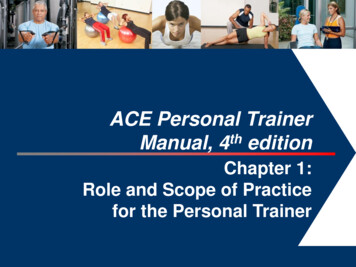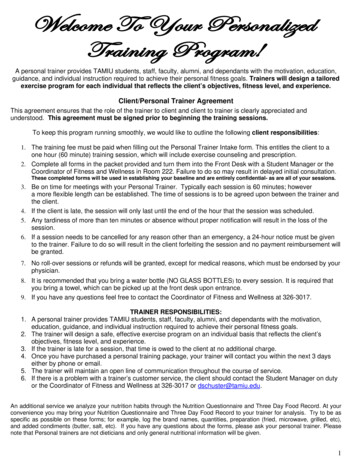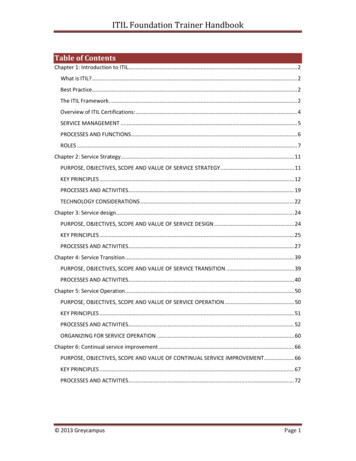
Transcription
ITIL Foundation Trainer HandbookTable of ContentsChapter 1: Introduction to ITIL. 2What is ITIL? . 2Best Practice. 2The ITIL Framework. 2Overview of ITIL Certifications: . 4SERVICE MANAGEMENT . 5PROCESSES AND FUNCTIONS . 6ROLES . 7Chapter 2: Service Strategy. 11PURPOSE, OBJECTIVES, SCOPE AND VALUE OF SERVICE STRATEGY . 11KEY PRINCIPLES . 12PROCESSES AND ACTIVITIES. 19TECHNOLOGY CONSIDERATIONS . 22Chapter 3: Service design . 24PURPOSE, OBJECTIVES, SCOPE AND VALUE OF SERVICE DESIGN . 24KEY PRINCIPLES . 25PROCESSES AND ACTIVITIES. 27Chapter 4: Service Transition . 39PURPOSE, OBJECTIVES, SCOPE AND VALUE OF SERVICE TRANSITION . 39PROCESSES AND ACTIVITIES. 40Chapter 5: Service Operation . 50PURPOSE, OBJECTIVES, SCOPE AND VALUE OF SERVICE OPERATION . 50KEY PRINCIPLES . 51PROCESSES AND ACTIVITIES. 52ORGANIZING FOR SERVICE OPERATION . 60Chapter 6: Continual service improvement . 66PURPOSE, OBJECTIVES, SCOPE AND VALUE OF CONTINUAL SERVICE IMPROVEMENT. 66KEY PRINCIPLES . 67PROCESSES AND ACTIVITIES. 72 2013 GreycampusPage 1
ITIL Foundation Trainer HandbookChapter 1: Introduction to ITILWhat is ITIL? As described by the officials, “ITIL is the most widely adopted approach for IT ServiceManagement in the world. It provides a practical, no-nonsense framework for identifying,planning, delivering and supporting IT services to the business.”It simply is a set of best practices in the field of IT Service Management.ITIL advocates that IT services must be aligned to the needs of the business and underpin thecore business processes. It provides guidance to organizations on how to use IT as a tool tofacilitate business change, transformation and growth.ITIL Best Practices also underpin the foundations of ISO/IEC 20000 (previously BS15000), theInternational Service Management Standard for organizational certification and compliance.Organizations can therefore implement ITIL to achieve organizational certification.Trainer Note: ITIL has been adopted by thousands of organizations worldwide, such as NASA, theUK National Health Service (NHS), HSBC bank and Disney . ITIL is also supported by quality servicesfrom a wide range of providers including examination institutes, accredited training providers andconsultancies, software and tool vendors and well known service providers such as IBM, Telefonica,HP and British telecom (BT).Best Practice Organizations operating in dynamic environments need to improve their performance andmaintain competitive advantage.There are several sources for these best practices, e.g.:o Public frameworks and standards validated across diverse environments knowledge is widely distributed among professionals there is publicly available training and certification Acquisition of knowledge through the labour market is easier, as iscollaboration and coordination across organizations.o Proprietary knowledge of organizations and individuals This is customized for the local context and specific business needs may only be available under commercial termsThe ITIL FrameworkThe ITIL framework is a source of best practice in service management. It is: Vendor-neutralNon-prescriptiveBest practiceITIL is successful because it describes practices that enable organizations to deliver benefits, returnon investment and sustained success, enabling organizations to:ITIL is a registered trade mark of the Cabinet Office, United Kingdom 2013 GreycampusPage 2
ITIL Foundation Trainer Handbook Deliver value for customers through services, improving customer relationshipsIntegrate the strategy for services with the business strategy and customer needsMeasure, monitor and optimize IT services and service provider performance and reducecostsManage the IT investment and budget, risks, knowledge, capabilities and resources todeliver services effectively and efficientlyEnable adoption of a standard approach to service management across the enterpriseChange the organizational culture to support the achievement of sustained success.ITIL has been deployed successfully around the world for morethan 20 years.Service LifecycleAn approach to IT service management that emphasizes the importance of coordination and controlacross the various functions, processes and systems necessary to manage the full lifecycle of ITservices. The service lifecycle approach considers the strategy, design, transition, operation andcontinual improvement of IT services. Crown copyright 2013 Reproduced under license from OGC 2013 GreycampusPage 3
ITIL Foundation Trainer HandbookFigure: The ITIL service lifecycleOverview of ITIL Certifications:ITIL FoundationThe Foundation Level is the entry level qualification which offers delegates a general awareness ofthe key elements, concepts and terminology used in the ITIL Service Lifecycle, including the linkagesbetween Lifecycle stages, the processes used and their contribution to Service Managementpractices.This qualification is primarily aimed towards: those who require a basic understanding of the ITIL frameworkthose who need understanding of how ITIL can be used to enhance the quality of IT servicemanagement within an organizationIT professionals or others working within an organization that has adopted and adapted ITILwho need to be informed about, or contribute to an ongoing service improvementprogramme.The ITIL qualification is open to any individuals who may have an interest in the subject.The ITIL Foundation qualification is not intended to enable the holders of the qualification to applythe ITIL practices for Service Management without further guidance.ITIL Intermediate LevelITIL Intermediate level has a modular structure with each module holding a different focus.Delegates can take as few or as many Intermediate qualifications as they require, and to suit theirneeds. The Intermediate modules go into more detail than the Foundation level, and are an industryrecognised qualification.Delegates who are seeking a management/team leader role in their company that requires a broadmanagement focus of ITIL practice areas and work across teams or manage multiple capability areas,the Service Lifecycle modules will be of interest to them: Service StrategyService DesignService TransitionService OperationContinual Service ImprovementFor delegates who are looking to gain intense, specialized, process-level knowledge in one or moreprocess, with focus on the day-to-day execution of ITIL practices, the Service Capability modules willbe of interest: Service Offerings and AgreementsRelease, Control and ValidationOperational Support and AnalysisPlanning, Protection and Optimization 2013 GreycampusPage 4
ITIL Foundation Trainer HandbookSome individuals may wish to concentrate on one stream of modules, however delegates may alsochoose to select modules from both Service Lifecycle and Service Capability streams to gain a holisticview of an entire stage from both a high level management level and the detailed, technicalperspective.To be eligible for any of the Intermediate exams delegates need to complete mandatory accreditedtraining.ITIL Managing Across the Lifecycle QualificationThe ITIL Managing Across the Lifecycle (MALC) qualification is a capstone qualification which is thefinal required module that a candidate must take prior to achieving ITIL Expert Level.The learning outcomes of MALC module are intended to bring a candidate from ITIL contentknowledge to ITIL content application and integration knowledge, and to provide skills that can beused in the workplace in a tangible way.This module is aimed at individuals who are interested in achieving the ITIL Expert Level, for whichthis module is a key requirement.ITIL Expert LevelThe ITIL Expert level of qualification is aimed at those individuals who are interested indemonstrating a superior level of knowledge of the ITIL Scheme in its entirety.Achieving this level of ITIL qualification will benefit a candidate in both their personal andprofessional development, by aiding career advancement and progression within the IT ServiceManagement field.Candidates who achieve ITIL Expert level will also satisfy the prerequisite entry criteria for the ITILMaster Level; the highest level qualification within the ITIL scheme.ITIL Master QualificationThe ITIL Master Qualification Certificate validates the capability of the candidate to apply theprinciples, methods and techniques from ITIL in the workplace.To achieve the ITIL Master Qualification the candidate must be able to explain and justify how theyselected and individually applied a range of knowledge, principles, methods and techniques from ITILand supporting management techniques, to achieve desired business outcomes in one or morepractical assignments.For more details, please visit www.itil-officialsite.com.SERVICE MANAGEMENTTo understand what service management is, we need to understand what services are, and howservice management can help service providers to deliver and manage these services.ServiceA means of delivering value to customers by facilitating outcomes customers want to achievewithout the ownership of specific costs and risks. The term 'service' is sometimes used as a synonymfor core service, IT service or service package. 2013 GreycampusPage 5
ITIL Foundation Trainer HandbookIT service A service provided by an IT service provider. An IT service is made up of a combination ofinformation technology, people and processesA customer-facing IT service directly supports the business processes of one or morecustomers and its service level targets should be defined in a service level agreement. OtherIT services, called supporting services, are not directly used by the business but are requiredby the service provider to deliver customer-facing services.OutcomeThe result of carrying out an activity, following a process, or delivering an IT service etc. The term isused to refer to intended results as well as to actual results.Services can be classified as: Core services: Deliver the basic outcomes desired by one or more customersEnabling services: Needed for a core service to be deliveredEnhancing services: Added to core services to make them more appealing to the customer.Service management is concerned with more than just delivering services. Each service, process orinfrastructure component has a lifecycle, and service management considers the entire lifecyclefrom strategy through design and transition to operation and continual improvement.PROCESSES AND FUNCTIONSProcessA process is a structured set of activities designed to accomplish a specific objective. A process takesone or more defined inputs and turns them into defined outputs. It may include any of the roles,responsibilities, tools and management controls required to reliably deliver the outputs. A processmay define policies, standards, guidelines, activities and work instructions if they are needed.Processes define actions, dependencies and sequence. Processes have the following characteristics: Measurability Processes can
ITIL advocates that IT services must be aligned to the needs of the business and underpin the core business processes. It provides guidance to organizations on how to use IT as a tool to facilitate business change, transformation and growth. ITIL Best Practices also underpin the foundations of ISO/IEC 20000 (previously BS15000), the International Service Management Standard for .
